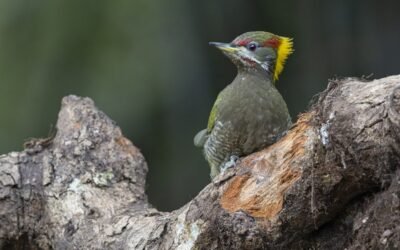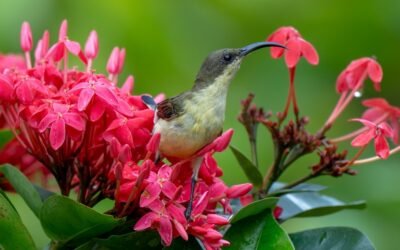Summary
Great Backyard Bird Count (GBBC) is a four day fun-event that happens each year in February with birdwatchers across the world engaging in watching, listening and listing birds through a free initiative called eBird.
Just like in previous years, the 12th edition of GBBC India was a resounding success. Between 16 to 19 February, 2024, around 5,334 eBirders uploaded 58,276 checklists and recorded 1,036 species—75% of the total number of species known to occur in the country.
Congratulations to all the birdwatchers and nature enthusiasts from across the country who made this event a success! A special shout out to all those who took this opportunity to conduct public bird walks and talks in their regions and campuses and introduce new people to the wonders of birds and nature.
Note: The numbers presented in these results may slightly vary from the global results.
Scroll down to view Campus Bird Count (CBC) results.
Click here to see a list of all eBirders who participated in this year’s GBBC.
Table 1: Summary of GBBC 2024 Vs. GBBC 2023
| GBBC 2024 | GBBC 2023 | |
| Participants | 5,334 | 4,259 |
| Lists | 58,276 | 53,750 |
| Species | 1,036 | 1,072 |
| Districts | 511 | 459 |
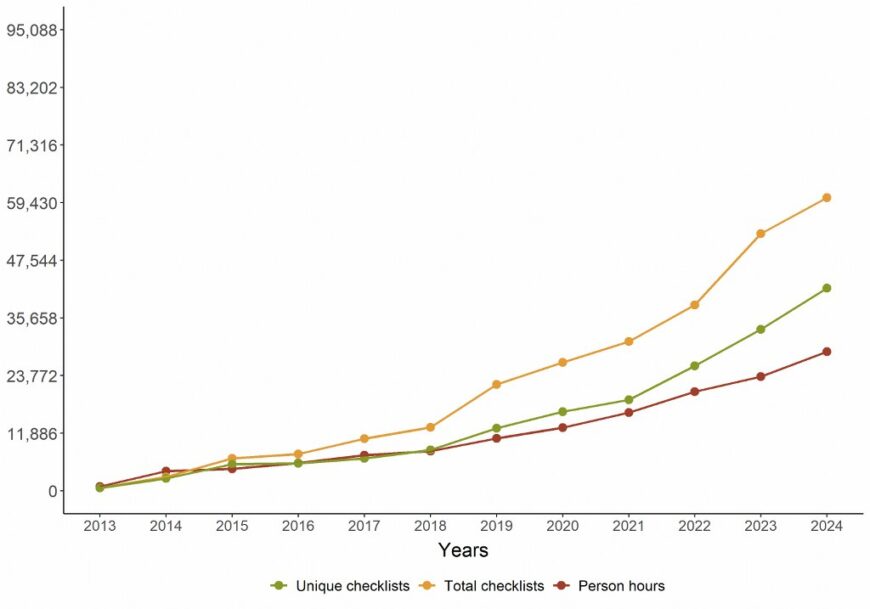
Fig 1: Graph depicting growth in terms of unique lists (not including shared lists), total checklists (including shared lists) and person hours, from 2013 to 2024.
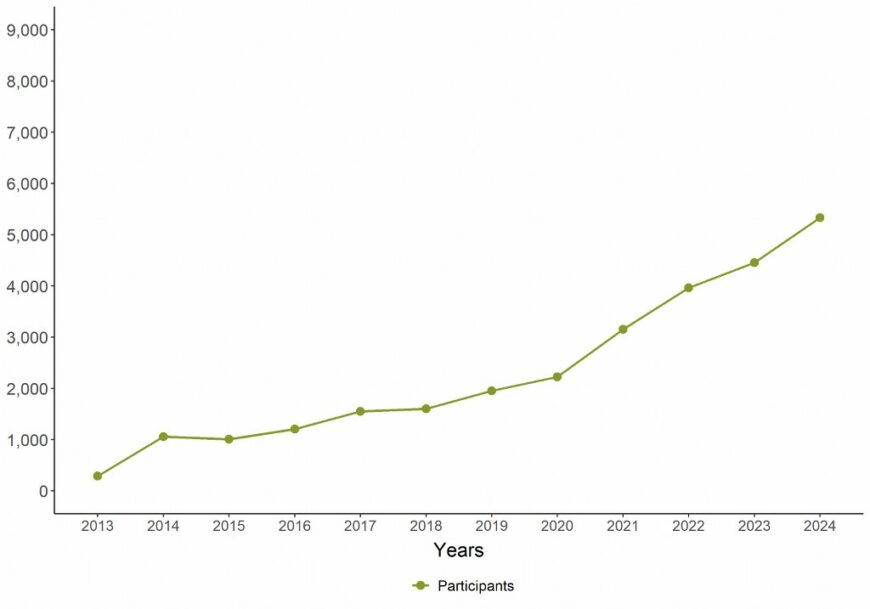
Fig 2: Graph depicting growth in terms of number of participants from 2013 to 2024
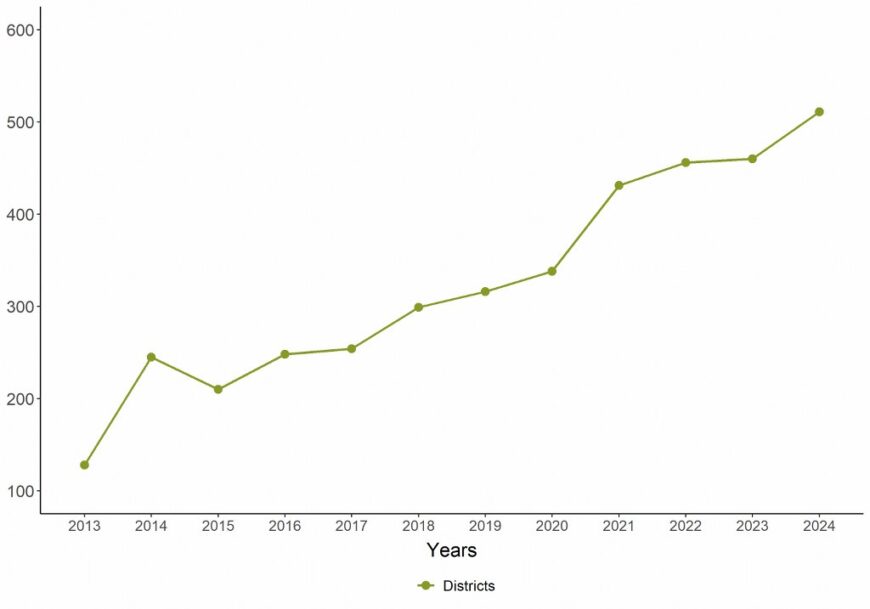
Fig 3: Graph showing growth in district participation
GBBC Global
At a global level, India did very well, uploading the second-highest number of checklists and the third-highest species of any country. Click here to see the global ranking.
GBBC India
In many states, there was an increase in number of eBirders compared to GBBC 2023. Karnataka had over 200 new eBirders and states like Maharashtra, Tamil Nadu, West Bengal had over 100 new eBirders participating this GBBC.
Table 2: List of all states and union territories that had new eBirders in GBBC 2024
| State/ UT | #new ebirders |
| Karnataka | 221 |
| Maharashtra | 132 |
| Tamil Nadu | 109 |
| West Bengal | 102 |
| Madhya Pradesh | 96 |
| Gujarat | 84 |
| Assam | 58 |
| Himachal Pradesh | 57 |
| Uttarakhand | 55 |
| Kerala | 50 |
| Uttar Pradesh | 39 |
| Meghalaya | 35 |
| Goa | 34 |
| Telangana | 32 |
| Odisha | 30 |
| Delhi | 15 |
| Bihar | 14 |
| Sikkim | 12 |
| Haryana | 12 |
| Jammu and Kashmir | 10 |
| Punjab | 9 |
| Chandigarh | 9 |
| Andhra Pradesh | 6 |
| Tripura | 2 |
Table 3: Top ten states and union territories in terms of percentage increase in number of eBirders
| State/ UT | % increase in eBirders |
| Meghalaya | 269% |
| Chandigarh | 180% |
| Madhya Pradesh | 77% |
| Goa | 66% |
| Sikkim | 54% |
| Himachal Pradesh | 53% |
| West Bengal | 42% |
| Bihar | 41% |
| Gujarat | 40% |
| Telangana | 30% |
Table 4: Top ten states and union territories in terms of percentage increase in number of lists
| State/ UT | % Increase in checklists |
| Sikkim | 259% |
| Chandigarh | 237% |
| Meghalaya | 217% |
| Odisha | 196% |
| Madhya Pradesh | 187% |
| Jammu and Kashmir | 86% |
| Telangana | 68% |
| Kerala | 43% |
| Assam | 38% |
| Bihar | 35% |
In this map, each list contributed to GBBC is shown as a translucent circle. Deeper yellow indicates overlapping circles, which signals more lists from that location.
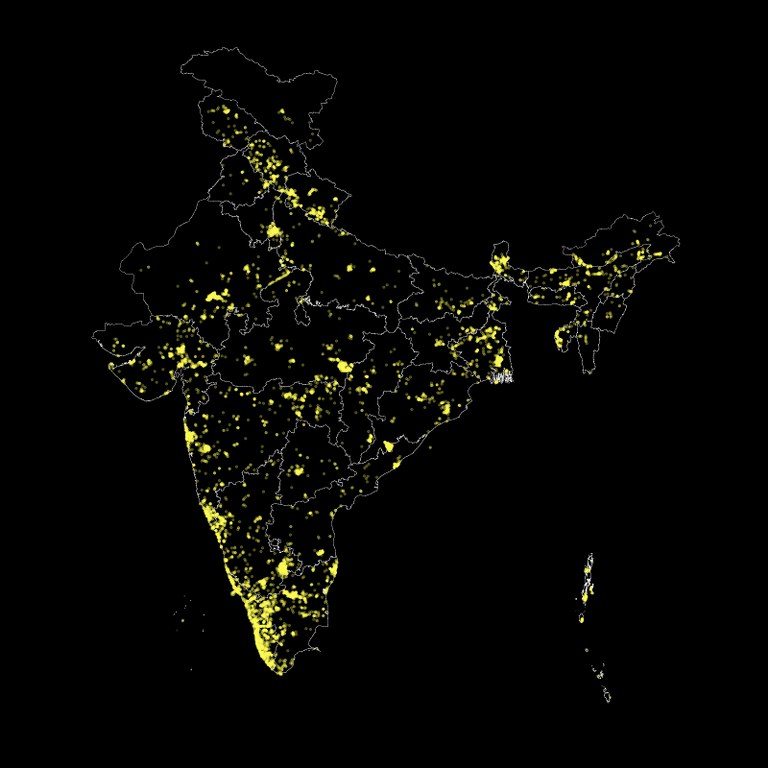
Fig 4: GBBC 2024 Coverage Map
Highlights from GBBC 2024:
Compared to GBBC 2023, this year saw a 3% decrease in species reported; however, there was a 12% increase in the number of lists, contributed by 25% more eBirders. The event also saw an 11% increase in district participation compared to the previous year.
Note that this was the first GBBC where all 37 states and union territories participated! In many regions, birdwatchers were able to cover all of their districts.
Note: The below HTML maps are best viewed on a computer.
Fig 5: GBBC 2024 State/UT coverage. To see the GBBC summary for any state or union territory, zoom in and click on the specific region.
Fig 6: GBBC 2024 District coverage. To see the GBBC summary for any district, zoom in and click on the specific region.
Table 5: Top eBirders in each state and union territory, in terms of the number of 15 mins checklists uploaded
| State/ UT | Participant Name | 15 min lists |
| Tamil Nadu | Angeline Mano M | 384 |
| Tripura | Krishnendu Das | 358 |
| Kerala | Abhin M Sunil | 293 |
| Andhra Pradesh | Janardhan Uppada | 213 |
| Gujarat | Birder Baba | 211 |
| Andaman and Nicobar Islands | Amrit Raha | 196 |
| West Bengal | Anish Bera | 155 |
| Maharashtra | Jeevak Shravasti | 154 |
| Odisha | Abhijit Hota | 147 |
| Sikkim | Rozan Dhungel | 136 |
| Madhya Pradesh | Urjit Singh | 129 |
| Rajasthan | Gaurav Singh | 80 |
| Chhattisgarh | Harish Kumar Verma | 82 |
| Uttarakhand | Sarabjeet Kaur | 78 |
| Assam | Jugal Borah | 77 |
| Karnataka | Gowshikha Rajamani | 74 |
| Arunachal Pradesh | Micah Rai | 69 |
| Meghalaya | Bikash Dalbot Shira | 60 |
| Bihar | Rahul Kumar (Bipsa) | 33 |
| Telangana | Murari Varma | 26 |
| Uttar Pradesh | Prakash Chitragupta | 23 |
| Goa | Tuk Tuk | 22 |
| Delhi | Alok Kumar | 14 |
| Jammu and Kashmir | Aakib Hussain | 14 |
| Jharkhand | Rishabh Lohia | 13 |
| Punjab | Sanjiv Khanna | 13 |
| Haryana | Anoop Singh Chauhan | 12 |
| Himachal Pradesh | Rohit Sharma | 12 |
| Nagaland | Risthong Yimchunger | 11 |
| Ladakh | Choldan Gasha | 10 |
| Chandigarh | Lalit Mohan Bansal | 7 |
| Manipur | Premjit Elangbam | 5 |
| Mizoram | Christopher Lawlor | 5 |
| Dadra and Nagar Haveli | Saswat Mishra | 4 |
| Puducherry | Varada Varier | 4 |
| Lakshadweep | Rajdeep Mitra | 3 |
| Daman and Diu | Saswat Mishra | 1 |
The total number of checklists presented in this summary may vary from the global results as some checklists containing 0 species have not been included here. If any of you have 0 species-15 minutes-complete lists made during GBBC 2024, then please email at skimmer@birdcount.in. Table updated on 15-04-2024.
Kudos to everyone who played a pivotal role in improving their regions’ participation in GBBC 2024!
A shoutout to the Andaman Avians Club, Birdwatchers’ Society of West Bengal, Eco Warriors- Nagaland, Foundation for Ecological Society (FES), Himachal Pradesh Forest Department, Nandan Kanan Zoological Park, Salem Ornithological Foundation (SOF), Thanamir Community Conservation Programme, WWF- India, and all the other groups for their wonderful efforts in planning, coordinating and participating in this event.
What were the common species reported?
In every GBBC, we analyse the frequency* of the top five most reported species from seven broad regions of the country.
This year, the two most commonly reported species are Common Myna (excluding the Himalayas and West), followed by Feral Pigeon (excluding the Andaman and Nicobar Islands and East). This year, Feral Pigeon made its appearance in the top five in the Himalaya and South, whereas it was absent in these two regions in the previous two GBBCs. The prevalence of Feral Pigeon as the second most common species in many regions of India agrees with the findings in the State of India’s Birds report, which highlights a rapid increase in the reporting of this species.
*Frequency is the percentage of checklists reporting that species within a specified date range and region
Fig 7: : Top five most commonly reported species in India based on the frequency of reporting in eBird during GBBC 2024
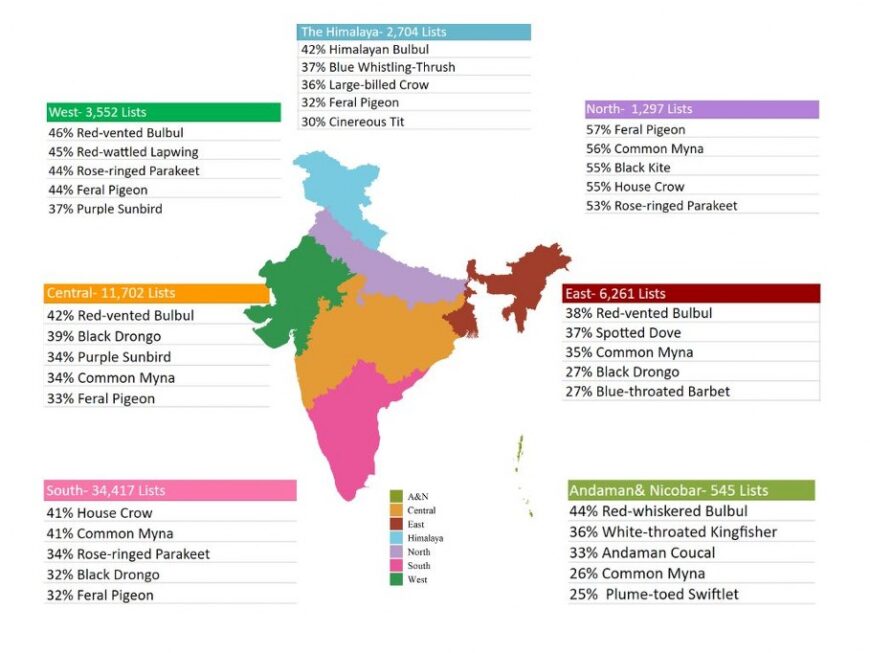
The Himalaya: Common Myna, which consistently ranked in the top 5 for the past two years, was replaced by the Feral Pigeon this year.
North: This region has consistently reported the same set of species since 2022, with minor changes in reporting frequency. Last year, House Crow ranked first among the top 5, whereas this year it is Feral Pigeon.
East: Looking at the previous two years’ GBBC, the ranking order of species in the top 5 remains the same, except for the 5th most reported species: in 2022, it was Oriental Magpie Robin; in 2023, it was Common Tailorbird; and this year, it is Blue-throated Barbet.
Andaman & Nicobar Islands: The reporting frequency of Plume-toed Swiftlet in the last two years was 56%; however, this year, the reporting frequency decreased to 25%. Ornate Sunbird (Olive-backed) and Asian Koel, which were in the top 5 in GBBC 2023, were replaced by the White-throated Kingfisher and Andaman Coucal this year.
South: Feral Pigeon was absent among the top 5 from the last two GBBCs but was present this year, replacing the White-throated Kingfisher, which had been consistently reported in the last couple of years.
Central:While Red-vented Bulbul, Black Drongo, Common Myna, and Feral Pigeon remained in the top 5, Purple-Sunbird replaced Rose-ringed Parakeet this year.
West: Purple Sunbird, which was reported among the top 5 in GBBC 2022 but absent in GBBC 2023, resurfaced in this year’s GBBC, replacing the Eurasian Collared Dove from last year’s top 5.
Does the emergence of Purple Sunbird and Blue-throated Barbet in the top 5 lists indicate that fruit and nectar feeders are on the rise, as reported in the State of India’s Birds 2023 report?
Stay Connected with Birds, Nature and Each Other
- The next GBBC/CBC will be on 14– 17 February, 2025.
- If you want to start your birdwatching journey or show others the joy of birding, there’s no need to wait until the next GBBC! You can start birding right away and upload your checklists to eBird. First, download these two important free apps: the Merlin Bird ID App and the eBird App. You can find ‘How to’ videos and webinars on Bird Count India’s YouTube channel.
- If you are new to birds and nature, consider subscribing to The Flock!
- For more information, you could also contact our Regional Coordinators listed here.
- To stay up-to-date with birding events across the country, bookmark this page: birdalliance.in.
- If you conduct regular bird or nature walks, please let us know so that we can list them here.
Campus Bird Count Results
The Campus Bird Count (CBC) runs alongside GBBC in India to record the birdlife on the multiple campuses across India and to promote birdwatching within institutions. This year, a total of 178 campuses across India participated, uploading a total of 6.058 unique checklists. These campuses include educational and training institutions, government institutions, research stations, zoological and botanical parks, corporate campuses, and so on.
Click here to see a list of all eBirders who participated in this year’s CBC.
Click here to see the full list of campuses in terms of total number of lists uploaded.
Table 6: Top campuses in terms of over ten participants, total species, and most commonly reported species in each.
| Campus Name | #eBirders | Total Species | Most Common Species |
| Kerala Agricultural University–General Area | 66 | 121 | House Crow |
| Fergusson College Campus | 58 | 80 | Black Kite |
| Wildlife Institute of India (WII) | 58 | 182 | Black Kite |
| Kerala Agricultural University–Krishi Vignyan Kendra | 57 | 103 | White-cheeked Barbet |
| Kerala Agricultural University–Botanical Garden | 47 | 94 | White-cheeked Barbet |
| GKVK Campus | 42 | 113 | Large-billed Crow |
| College of Forestry–Nursery, Dapoli | 40 | 130 | Red-vented Bulbul |
| Kerala Agricultural University–ACCER | 40 | 44 | House Crow |
| Stella Maris College | 36 | 30 | Rose-ringed Parakeet |
| Navsari Agricultural University (NAU) | 36 | 122 | Black Drongo |
| Kerala Agricultural University–Arboretum | 35 | 82 | White-cheeked Barbet |
| College of Veterinary and Animal Sciences, Pookode | 29 | 125 | Red-whiskered Bulbul |
| Forest Research Institute (FRI), New Forest Campus | 29 | 189 | Rose-ringed Parakeet |
| Orissa University of Agriculture And Technology | 28 | 98 | Feral Pigeon |
| IISER Tirupati–Yerpedu Campus | 24 | 133 | House Crow |
| IISc Bangalore | 20 | 69 | Black Kite |
| Forest College and Research Institute (FCRI) | 19 | 31 | Indian Robin |
| National Institute of Technology (NITK), Surathkal | 19 | 101 | Asian Koel |
| Symbiosis International University, Lavale | 18 | 43 | Large-billed Crow |
| IIT Bombay | 17 | 97 | Black Kite |
| SN College, Cherthala(Restricted access) | 15 | 26 | Brahminy Kite |
| Bangalore Life Science Cluster (BLiSC) | 15 | 55 | Black Kite |
| Aligarh Muslim University (AMU)–General Area | 13 | 53 | Common Myna |
| Krantisinh Nana Patil College of Veterinary Sciences,Shirwal | 13 | 79 | Purple Sunbird |
| Bharati Vidyapeeth Institute of Environment Education & Research (BVIEER) | 13 | 36 | House Crow |
| IISc Bangalore–Jubilee Gardens | 13 | 58 | Black Kite |
| IIT Madras (Restricted Access) | 12 | 71 | Rose-ringed Parakeet |
| Gujarat University | 12 | 50 | Asian Koel |
| Agumbe Rainforest Research Station (ARRS) | 11 | 121 | Crimson-backed Sunbird |
| Central University | 11 | 77 | Feral Pigeon |
| Cotton University | 11 | 38 | House Crow |
| IISER Pune | 11 | 66 | Common Myna |
| Empress Botanical Garden | 11 | 52 | Black Kite |
| University of Science and Technology Meghalaya | 11 | 21 | Barn Swallow |
| Christ University–Main Campus | 10 | 43 | Black Kite |
| Maharaja Sayajirao University (MS University) Campus | 10 | 73 | Feral Pigeon |
Fig 8: CBC 2024 Coverage. Campuses that participated are marked in coloured circles. To see the summary of a specific campus, zoom in and click on the circle.
Congratulations to all campus leaders, participants, and volunteers for their commitment to the Campus Bird Count! Let us continue to monitor our campus ecosystems and document bird diversity through frequent birding activities.
Note: If your campus participated in the event but is not shown here, it means that the lists were not uploaded to the correct campus eBird Hotspot ID or your campus was not registered. If you have any doubts or queries regarding this, please write to us at skimmer@birdcount.in
The next Campus Bird Count will be on 14– 17 February, 2025
Banner Image: People Watching Birds during GBBC 2024 at Prayagraj. Photo by Mark Menezes


